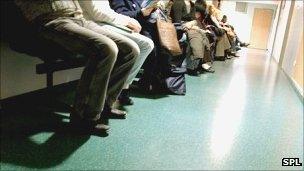Analysis: How bad is hospital waiting getting?
- Published

Hospitals are expected to see patients within 18 weeks of GP referral n England
East Cheshire is a typical medium-sized NHS trust.
It runs three hospitals providing a wide-range of care for an area covering 200,000 people.
Each year it carries out 16,000 non-emergency operations.
And, like the rest of the NHS, it aims to see 90% of those patients within 18 weeks of GP referral - the 10% leeway is allowed to reflect the fact that some patients may choose to wait longer for valid personal or medical reasons.
A year ago it was meeting the target with ease. Some 96% of patients were seen within that timeframe in June 2010.
However this year it is a very different picture, and the figure has fallen to 62%.
Orthopaedics, which covers knee and hip operations, has been the worst hit. Less than half of these cases - many involving the elderly - were seen within 18 weeks.
The trust has blamed the drop in performance on the difficult winter - demand for hospital treatment rises when it is colder - but with money getting ever tighter in the NHS it has found it difficult to catch up.
Kath Senior, East Cheshire's director of nursing, agreed "progress was slower than planned", but insisted the trust would get on top of the situation by October.
Longer waits
But East Cheshire is not the only hospital trust facing problems.
Another 60 trusts did not hit the 90% standard in June compared to 25 during the same month last year.
What is more, for the patients who wait over 18 weeks the waits appear to be getting longer.
According to the June data, nearly 12,000 people waited longer than six months - up 61% in a year.

Despite the growing pressures on waiting times, the situation is still much better than it was in the 1990s
Of these, 718 had waited for more than 12 months.
And many fear it will get worse before it gets better.
The NHS is being asked to save money to the tune of 4% a year for the next four years.
Mike Farrar, of the NHS Confederation, which represents managers, said polling of finance directors by his organisation suggested waiting times would suffer.
He predicted they would become "stretched as the financial situation gets increasingly pressured" and warned there was "absolutely no room for complacency".
The government has attempted to stay calm despite the growing number of damaging headlines.
The official line is that waiting times remain "low and stable" with ministers consistently pointing that overall the 90% standard is being kept to.
But that is unlikely to satisfy the government's critics.
They point out that while it is true the overall figure is above 90% - just - this is only because some places are performing better than they need to.
Pressure is also growing in other areas, including in A&E and for cancer treatment.
Labour is gearing up to use NHS waiting times as a stick with which to beat the government fresh from what the party views as its success over the health reforms.
But the whole waiting time debate also needs to be seen in the context of the NHS's recent history.
The 718 patients seen in June who had waited for more than a year represented just 0.2% of the total seen during that month.
During the late 1990s, the figure was hovering around the 5% mark.
No matter how difficult the next few years prove, a return to those days seems unlikely.
- Published15 July 2011
- Published12 July 2011
- Published6 July 2011
- Published7 June 2011
- Published16 June 2011